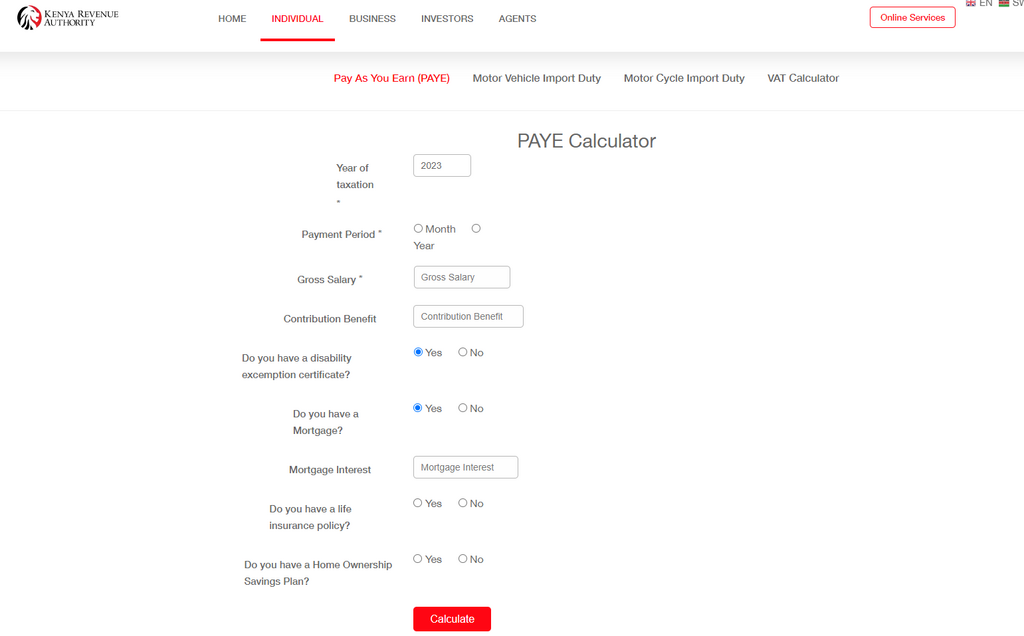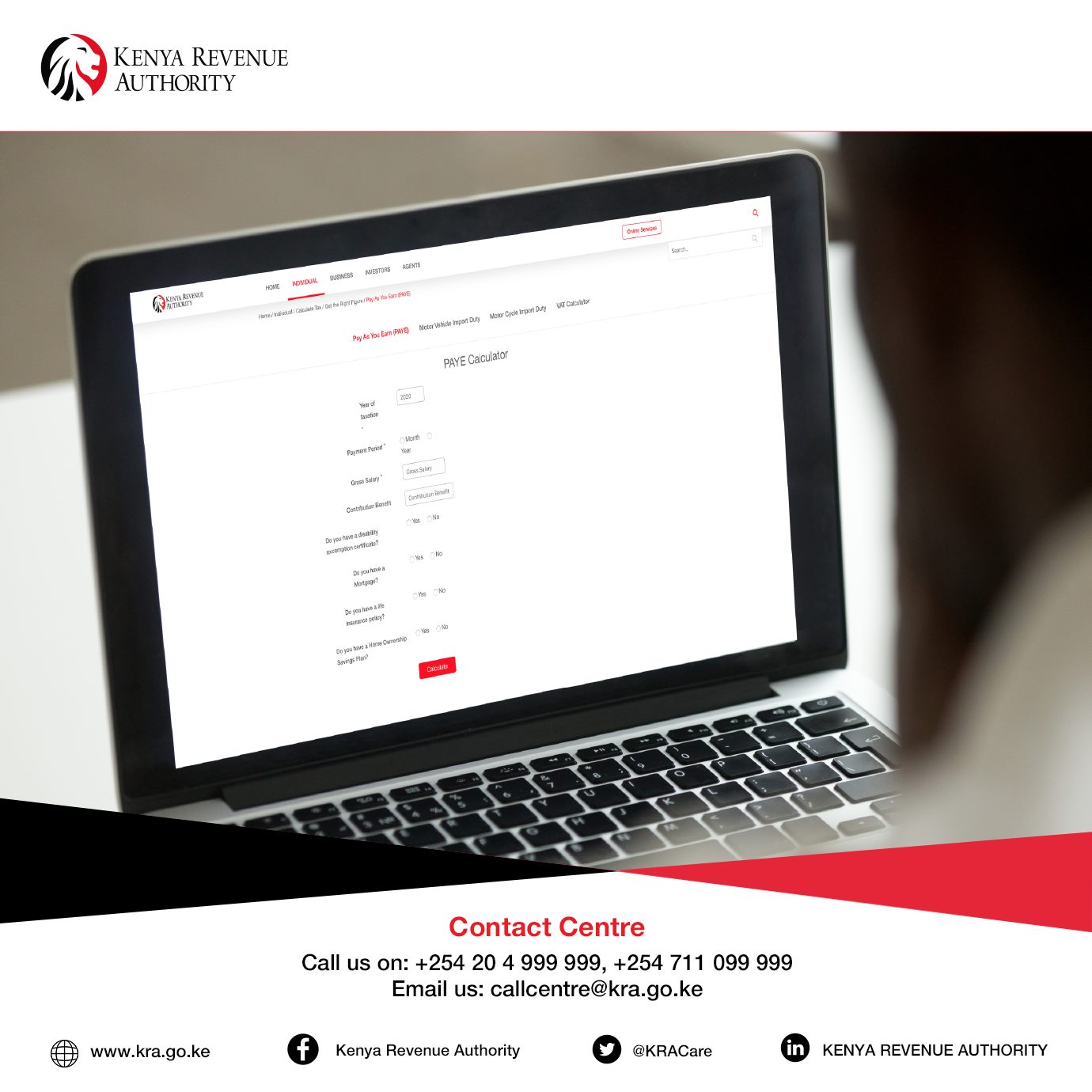Every day, Month and year is a Tax season for every Person in Kenya. It may be direct or indirect to your Knowledge. Similarly, the Kenya Revenue Authority (KRA) announces changes to the PAYE tax rates every year. And guess what 2024 is no different. Knowing PAYE Rates helps you plan your finances and avoid KRA penalties.
Well, it’s always challenging for many Kenyans to know what these Rates are. But it doesn’t have to be like that. There are countless tools out there that can help. While Most of these tools are outdated, it is best to use this guide to know the accurate Individual Income Tax Rates (Bands). KRA has up to 5 different bands that are vital when it comes to computing PAYE. These Bands range from 10% to 35% as per the Finance Act 2023.
To avoid all this confusion, let us jump into the article and understand what the KRA PAYE Tax Rates are
What is PAYE?
PAYE, which stands for Pay As You Earn, is a tax deducted directly from the salaries and wages of employees in Kenya. As the name suggests, you pay this tax as you earn your income. The Kenya Revenue Authority (KRA) administers PAYE, which is governed by the Income Tax Act.
Who is Subject to PAYE? If you’re employed and earning a salary or wages in Kenya, you’re likely subject to PAYE. It doesn’t matter if you’re a Kenyan citizen or a foreigner working in the country – the tax applies to everyone.
New KRA PAYE Tax Rates for 2025
The new tax brackets and rates are as follows:
PAYE Tax Rates (Effective 1st July 2023)
| Monthly Pay Bands (Ksh.) | Annual Pay Bands (Ksh.) | Rate of Tax (%) |
|---|---|---|
| On the first 24,000 | On the first 288,000 | 10% |
| On the next 8,333 | On the next 100,000 | 25% |
| On the next 467,667 | On the next 5,612,000 | 30% |
| On the next 300,000 | On the next 3,600,000 | 32.5% |
| On all income above 800,000 | On all income above 9,600,000 | 35% |
| Personal Tax Relief | 2,400 per month / 28,800 per year |
Pension Tax Rates (Effective 1st July 2023)
| Pension Tax Bands (Annual) | Tax Rates |
|---|---|
| On first 400,000 | 10% |
| On next 400,000 | 15% |
| On next 400,000 | 20% |
| On next 400,000 | 25% |
| On any amount in excess of 1,600,000 | 30% |
How is PAYE Calculated In Kenya?
Now that you have the Various Tax Rates based on income Band, you may also ask how much PAYE is deducted from your paycheck. Well, it all starts with your taxable income.
Not to be ignored, what is income is taxable anyway? This is essentially your gross pay minus any allowable deductions and reliefs. It’s like the final price you pay for something after applying all available discounts!
You can use the Mathematical formula: Gross taxable income= Basic pay + Taxable benefits + Allowances
Now, from the gross pay, we subtract things like personal relief, which is a fixed amount everyone is entitled to—currently, Ksh 2,400 per month or 28,800 per year. If you contribute to a registered pension scheme or have a qualifying insurance policy, you can also claim deductions. The amount left after these deductions is your taxable income.
This taxable income is now divided into different brackets or bands, each with its own tax rate, as mentioned in the tables above.
KRA online PAYE calculator
Now that you understand how the PAYE is Calculated in Kenya in theory, would it be awesome to test it? But hold on, why do it manually when there are tools for this? A good option to use is the KRA Paye calculator
All you have to do is visit the Calculator tool Page, input your income details, select the applicable deductions and reliefs, and hit the calculate button. It is as simple as that

How to file PAYE returns?
Once you know how much PAYE you owe, you can file your returns and pay. Failure to File your returns on time Can attract heavy penalties. Therefore to be on the safe side, here is how you can do it:
- Visit the KRA iTax portal and log in using your KRA PIN and password.
- Once Logged, Click the “Returns” tab and select the “File Return” option.
- Choose “Income Tax – PAYE” as your tax obligation.
- Download the Excel Return Form and proceed to compile your payroll data in the form.
- Enter the required employee payroll data accurately and correctly fill in other relevant details.
- Click on “VALIDATE” at the end of the sheet to ensure all data is correct.
- Proceed and upload the Zipped Return to your iTax profile.
- Mark the checkbox to agree to the terms and conditions.
- Click on the submit button. You will receive an acknowledgment receipt confirming the successful filing of your PAYE return.
Remember, If you have no PAYE to declare, you must submit a NIL Return.
What is the deadline for filing a PAYE?
The deadline for filing PAYE returns is the 9th of the following month, after the month in which the tax was deducted. For example, if you deduct PAYE from your employees’ salaries in January, you must file the return by February 9th.
If you miss the deadline, you may incur a penalty of KES 10,000 or 25% of the tax due, whichever is higher. Additionally, late payment incurs a penalty of 5% of the tax due, along with interest at a rate of 1% per month until the tax is paid.
How to calculate kra withholding tax?
The withholding tax rates depend on the type of income and whether the recipient is a resident or non-resident. The Current withholding tax rates are as follows:
| Type of Income | Withholding Tax Rate for Residents | Withholding Tax Rate for Non-Residents |
|---|---|---|
| Dividends | 5% | 10% |
| Interest | 15-25% (depending on type) | 15-25% (depending on type) |
| Royalties | 5% | 20% |
| Management, Professional, and Training Fees | 5% | 20% |
| Consultancy and Agency Fees | 5% | 20% |
| Contractual and Agency Fees | 3% | 20% |
| Rent (Buildings) | 12% | 30% |
| Winnings from Betting and Gaming | 20% | 20% |
To calculate the withholding tax, multiply the gross income amount by the applicable tax rate. For example, if a resident earns a management fee of Ksh 100,000, the withholding tax would be: Withholding tax = Ksh 100,000 x 5% = Ksh 5,000
Final Word
And there you have it—that’s all you need to know about the new KRA PAYE tax rates for 2025. I hope this guide has been very beneficial to you. By understanding how PAYE is calculated in Kenya and the reliefs, you can ensure that you are paying the right amount of Tax. So, I wish you all the best, but if you have any questions, please ask them in the comment sections below.










